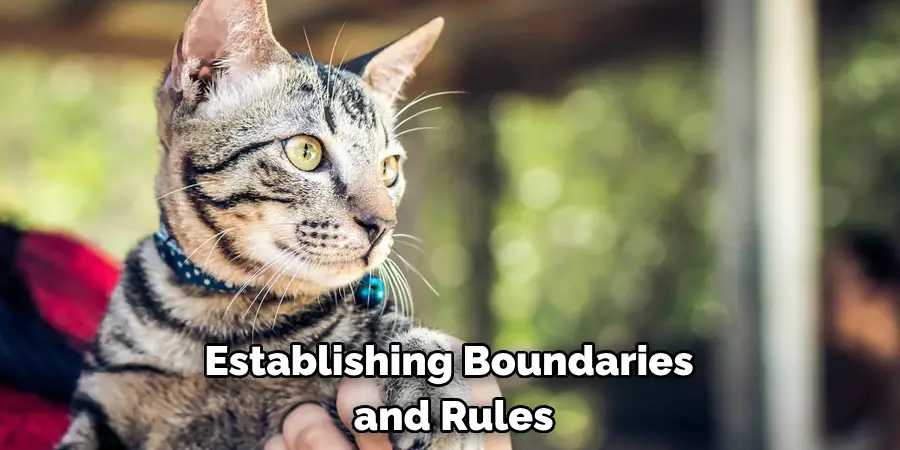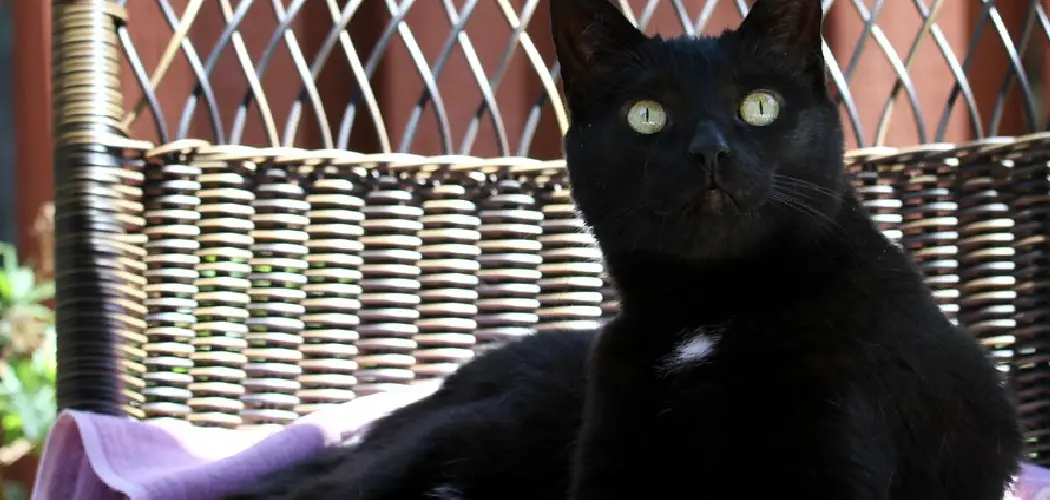Are you tired of dealing with your cats destroying your patio furniture? Do their claws ruin the fabric and scratch up your pieces’ surface, leaving them shabby and uninviting? Do you own a feline friend but constantly struggle to stop them from knocking over and scratching your patio furniture? As an owner of one or multiple cats, keeping them away from particular objects or items around the house can be challenging. But don’t worry – we’re here to help! Fortunately, you can use several excellent strategies to keep cats off patio furniture.

In this blog post, we’ll explore all the tips and tricks on how to keep cats off patio furniture while still providing a safe and comfortable environment for them. So, if you need practical solutions for preventing naughty kitties from ruining patio furniture – read on!
Necessary Items
Before diving into the different methods for keeping cats off patio furniture, having a few items on hand is essential. These items will come in handy when implementing any of the strategies mentioned below, and having them readily available will make your job much easier.
- Double-sided tape – This will be used to create a deterrent surface that cats won’t want to walk on.
- Aluminum Foil – Cats do not like the sound or feel of aluminum foil, so this can be used as a barrier to keep them away from furniture.
- Water Sprayer – A gentle spray bottle filled with water effectively discourages cats from jumping onto patio furniture.
- Citrus Spray – Cats dislike the smell of citrus, so that a homemade citrus spray can be used as a natural repellent for furniture.
- Cat Scratching Post – Providing an alternative scratching post will redirect your cat’s desire to scratch away from your patio furniture.
- Motion-activated Sprinkler – This option is more costly but highly effective in keeping cats off outdoor furniture and other areas of your yard.
10 Steps on How to Keep Cats Off Patio Furniture
Step 1: Use Double-Sided Tape
Place double-sided tape on the edges and surfaces of your patio furniture. Cats do not like the sticky feeling on their paws, so they will avoid walking or scratching in these areas. Replace the tape as needed.

Step 2: Cover Furniture with Aluminum Foil
Cover your patio furniture with foil, creasing it up and securing it tightly so that cats cannot easily remove or walk on it. The sound and texture of the foil will deter them from jumping onto or scratching the furniture.
Step 3: Create a Barrier with Water Sprayer
When you catch your cat attempting to jump onto patio furniture, use a gentle spray bottle filled with water to discourage them. This method is safe and effective, as it won’t harm your cat but will still act as a deterrent.
Step 4: Use Citrus Spray
Mix equal parts of lemon or orange juice and water in a spray bottle on your patio furniture. Cats dislike the scent of citrus, so this will keep them away from your furniture.

Step 5: Provide Alternative Scratching Options
Cats love to scratch, so providing a scratching post or mat near your patio furniture can redirect their scratching behavior away from your outdoor pieces.
Step 6: Utilize Motion-Activated Sprinkler
For a more high-tech solution, you can invest in a motion-activated sprinkler. This device will spray water when it detects movement, keeping cats away from your patio furniture and other yard areas.
Step 7: Train Your Cat with Positive Reinforcement
Using treats and praise, train your cat to stay off patio furniture and reward them when they use their scratching post instead.
Step 8: Use Scent Repellents
Cats dislike certain smells, such as lavender, peppermint, and eucalyptus. Spraying these scents on your furniture can keep them away.

Step 9: Make Furniture Less Appealing
Covering patio furniture with a plastic tablecloth or tarp can make it less appealing for cats to scratch or lounge on.
Step 10: Consider Indoor Furniture Covers
If your cat is still persistently trying to get on your patio furniture, consider using indoor furniture covers when the pieces are not in use. This will protect them from scratches and damage.
Keeping cats off patio furniture may seem daunting, but with the right strategies and tools, it can be easily achieved. You can successfully support your outdoor furniture safe from feline destruction by providing alternative options for scratching, using deterrents such as double-sided tape or water sprayers, and training your cat with positive reinforcement. Remember to ensure your cats have a comfortable and stimulating indoor environment to reduce their desire to explore and scratch outdoor furniture. You can create a harmonious living space for you and your feline friends with patience and consistency.
8 Additional Tips for Living Peacefully with Cats
Now that we’ve covered how to keep cats off patio furniture, here are some general tips to help you coexist peacefully and happily with your feline companions:
1. Establish Boundaries Early On
Establishing boundaries and rules for your cat from the beginning is essential. This will make it easier to train them and prevent behavior issues in the future.
2. Provide Plenty of Toys and Scratching Options
Cats need mental and physical stimulation, so provide a variety of toys and scratching options for them to play with. This will also help redirect their attention away from furniture.
3. Regularly Clean and Maintain Litter Boxes
Clean and maintain your cat’s litter boxes regularly to prevent them from finding other areas of your home to use as a bathroom. This will also help keep your house smelling fresh and clean.
4. Keep Indoor Plants Out of Reach
Some plants can be toxic for cats, so keep indoor plants out of reach or choose non-toxic varieties.

5. Pay Attention to Your Cat’s Body Language
Cats communicate subtly, so pay attention to their body language and vocalizations to better understand their needs and wants.
6. Establish a Routine for Feeding and Playtime
Cats thrive on routine, so establish a consistent schedule for feeding and playtime to help keep them happy and healthy.
7. Regular Vet Visits
Regular vet visits are crucial for your cat’s health and well-being. Make sure to schedule annual check-ups and keep up with vaccinations.
8. Show Your Cat Love and Affection
Lastly, remember to show your cat love and affection! Cats may have a reputation for being independent, but they still crave attention and affection from their owners. Spend quality time with your cat every day to strengthen your bond.
Following these tips can help create a peaceful and loving environment for you and your feline friends to coexist happily. With patience, understanding, and proper training, living with cats can be a joyous experience for all involved. So go ahead and enjoy
8 Things to Avoid
1. Using Harmful Deterrents
Avoid harsh chemicals or materials that could harm your cat, such as mothballs, cayenne pepper, or bleach. These can be toxic and dangerous to your furry friend.
2. Using Punishment
Punishing your cat for unwanted behavior is ineffective and can damage your relationship with them. It’s essential to use positive reinforcement and redirection instead.
3. Leaving Furniture Uncovered
Leaving patio furniture uncovered and exposed to cats can result in scratches, damage, and possible injuries. Always cover your outdoor pieces when not in use.

4. Neglecting Indoor Environment
A lack of stimulation or scratching options indoors can lead to a cat’s desire to explore and scratch outdoor furniture. Make sure to provide your cats with a comfortable and enriched indoor environment.
5. Using Water Sprayers Too Aggressively
Avoid using water sprayers too aggressively or in a way that could scare your cat. The goal is to discourage behavior, not harm or traumatize them.
6. Neglecting Training
Consistency is critical when training your cat to stay off patio furniture. Neglecting to reinforce desired behaviors can lead to your cat reverting to old habits.
7. Using Citrus Spray on Sensitive Furniture
Be cautious when using citrus spray on sensitive materials, as it may cause discoloration or damage. Test a small area first before applying it to the entire piece.
8. Placing Scratching Posts in Inconvenient Locations
Make sure to place scratching posts in readily accessible and desirable locations for your cat. Otherwise, they may rub on your patio furniture out of convenience.
Overall, using safe and effective methods is essential when trying to keep cats off patio furniture. You can protect your outdoor pieces from feline behavior with patience and consistency, along with creating a stimulating indoor environment for your cat. Remember always to prioritize the well-being and happiness of your furry friend when implementing these strategies. So go ahead and enjoy your patio furniture without worrying about it being destroyed by your beloved feline companion!
Frequently Asked Questions
How Long Will It Take My Cat to Learn to Stay Off Patio Furniture?
Every cat is different, so the time it takes for them to learn this behavior can vary. With consistent training and positive reinforcement, most cats should be able to adapt within a few weeks.
Will These Methods Harm My Cat?
No, the methods suggested in this guide are safe and gentle ways to discourage cats from jumping onto patio furniture. Always prioritize your cat’s safety and well-being when implementing any strategies.
Can I Use These Methods on Other Types of Outdoor Furniture?
Yes, these methods can be applied to other types of outdoor furniture, such as garden chairs, tables, and benches. Just ensure that any materials used are safe for the specific furniture. Overall, these strategies can be effective for keeping cats off any outdoor furniture they are prone to scratching or lounging on. So feel free to use them as needed!
Should I Keep My Cat Indoors All the Time to Avoid This Issue?
While keeping your cat indoors can eliminate this problem, providing them with a stimulating environment and opportunities for outdoor exploration under supervision is essential. Ultimately, it’s a personal decision and depends on your cat’s needs and personality. Consult with your veterinarian for more personalized advice.
Conclusion
We hope this guide on how to keep cats off patio furniture has provided you with effective and safe ways to keep cats off patio furniture. Always prioritize your cat’s well-being and happiness, and be patient, as it may take some time for them to adapt.
With consistent training, positive reinforcement, and a stimulating indoor environment, you can protect your outdoor furniture while maintaining a harmonious relationship with your feline friend. Now, enjoy your outdoor space without worrying about your cat’s behavior!

